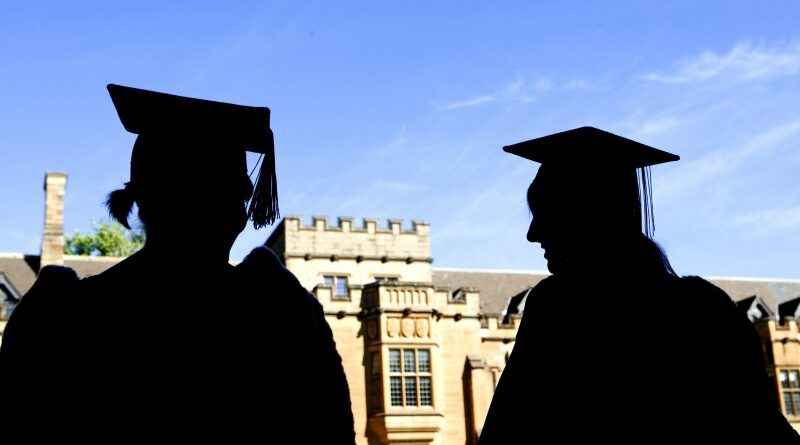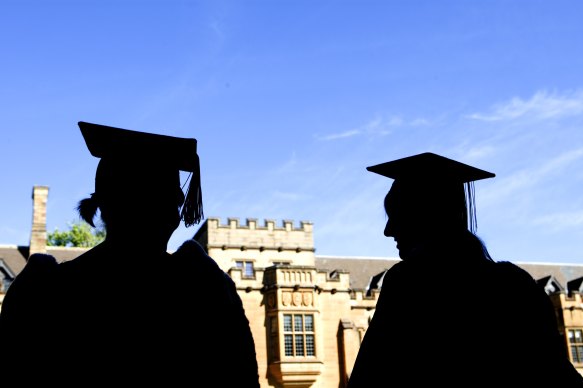Universities oppose caps, levies on overseas students amid plan to slash migration
Save articles for later
Add articles to your saved list and come back to them any time.
University chiefs are warning against the use of levies or caps on overseas students after the federal government said it could take further steps to curb arrivals if it did not see results from a sweeping plan to cut migration.
The universities are mobilising against calls for a levy or tax to raise billions of dollars and discourage arrivals, while expressing hopes the government would not pursue the “blunt instrument” of a cap on the number of students.
University chiefs are warning against the use of levies or caps on overseas students.Credit: Peter Braig
Home Affairs Minister Clare O’Neil unveiled the migration plan on Monday with a forecast that stronger integrity measures would help reduce net overseas migration from 510,000 last financial year to just 250,000 in the year to June 2025.
O’Neil said the 250,000 figure was an estimate but not a target because the government could not control every aspect of the system, but she said the new policies would stop the surge in student arrivals without hurting the universities.
“We expect to see that sector continue to grow, but we don’t want it to grow as fast as it has been growing in the past few years,” she said.
Asked if she wanted a cap on the student numbers, O’Neil said the goal was to avoid a “free-for-all” in which visitors from overseas wanted a good education but were exploited instead.
“If we do not succeed in that, of course there are other things that we can do,” she said about the cap.
“But I’m confident that the measures we have put together here are being done quickly and that we’ve caught this problem in time.”
While Coalition migration spokesman Dan Tehan accused Labor of creating a “big Australia” by allowing too many migrants, the government noted that Opposition Leader Peter Dutton had previously asked for an increase in the intake.
“It’s clear that the number needs to be higher,” Dutton said of the migrant intake in September last year.
Tehan said on Monday the government had “opened the doors” to record migration when Australians were suffering from housing shortages and a rental crisis.
Australia has 650,000 overseas students due to a surge in arrivals after the pandemic, making this a big part of the overall increase in net overseas migration and leading the government to impose a stricter language test and a tougher “genuine student test” to discourage people who come for work rights rather than education.
The government wants to encourage good students but has seen abuse of the system by private providers with poor-quality courses.
Group of Eight chief executive Vicki Thomson, who represents the oldest universities, said she believed the government had a cap on students on the agenda but was worried about a levy or tax that would raise revenue from student and institutions.
“We would be very concerned about and would absolutely reject the idea of a levy,” she said, adding that universities were a not-for-profit sector as well as a big export earner for the country.
The government estimates tertiary education generates $30 billion in annual export earnings for the country.
Thomson welcomed the migration plan announced on Monday and said her members believed they would grow as expected by 9 per cent this year because the stricter measures would most curb arrivals at private providers.
Universities Australia chief executive Catriona Jackson also welcomed the new measures but said government investment in research would have to increase significantly if the federal government imposed a cap on student numbers and cut the sector’s revenue.
“We argued strongly through the consultation process against a blunt policy instrument such as a cap, and we don’t see one in today’s announcement,” she said.
Education Minister Jason Clare will consider a levy or a cap after the ideas were raised in the debate over a “universities accord” with the sector.
Australian National University professor of higher education policy Andrew Norton said he doubted whether the government would invest the proceeds of any levy back into the sector.
“I’m not convinced it’s going to be a net benefit,” he said.
The changes for students are the biggest part of a plan that promises to cut net migration from 510,000 last financial year to 375,000 this year and 250,000 next year.
“It’s not a target, it’s an estimate,” O’Neil said when asked about the 250,000 figure.
“There are things about that number that are not within the control of government. One of the major inputs to the number are people leaving the country, and that’s not something the government gets to decide.
“So we don’t commit to those numbers as a target. They are estimates of the policy decisions that we’re making.”
O’Neil acknowledged the housing and infrastructure pressures in the major cities and said she wanted to run a migration program that maintained the support of the Australian community.
Cut through the noise of federal politics with news, views and expert analysis from Jacqueline Maley. Subscribers can sign up to our weekly Inside Politics newsletter here.
Most Viewed in Politics
From our partners
Source: Read Full Article




